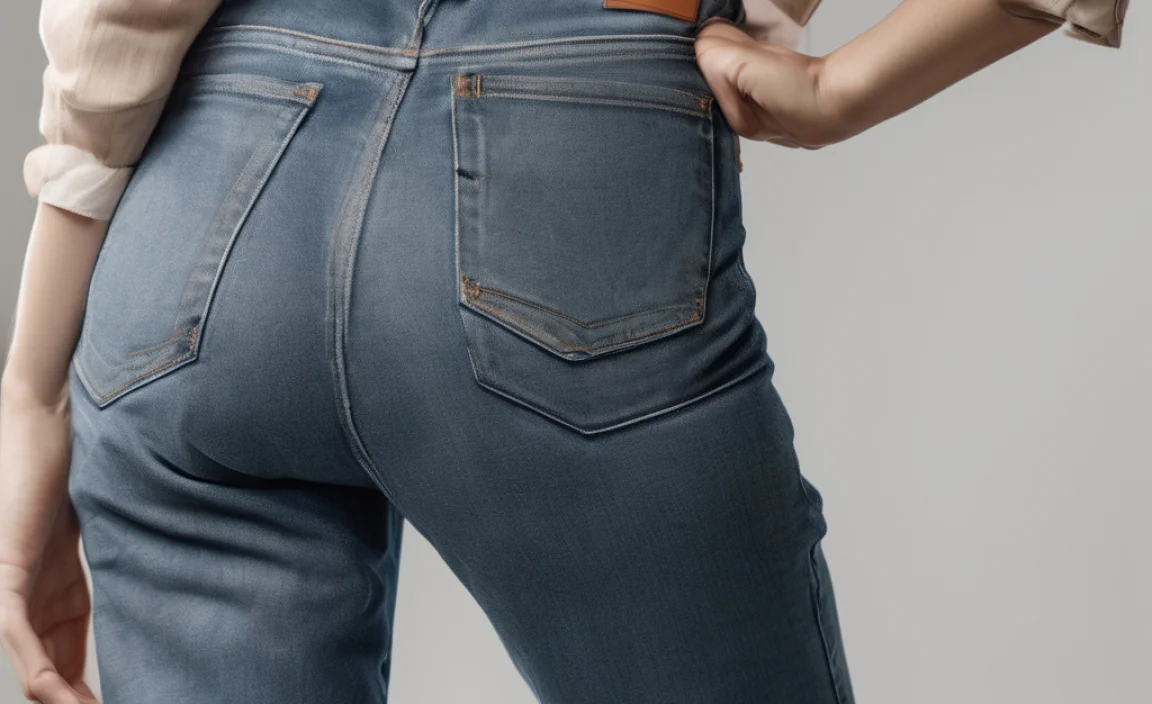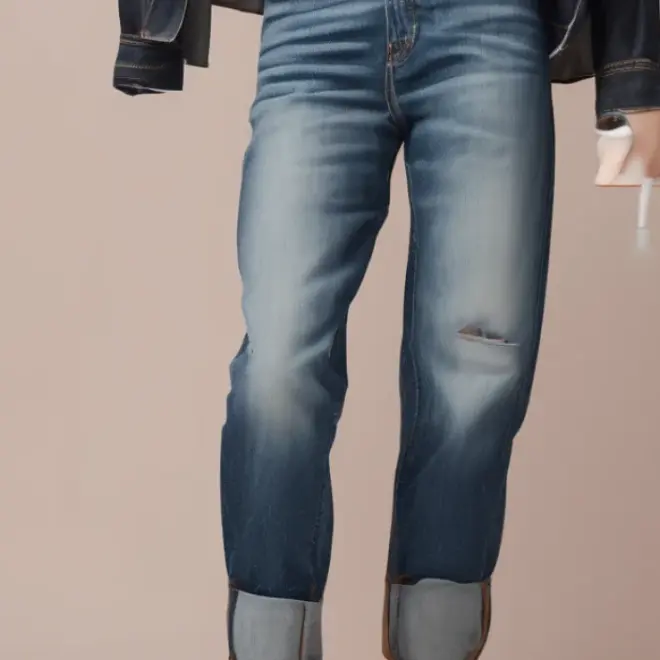Quick Summary
Learn how to hem mom jeans by hand for a custom, stylish fit. This easy-to-follow guide breaks down the process, perfect for beginners, ensuring you can achieve a professional-looking finish without a sewing machine, saving you time and money.
How to Hem Mom Jeans by Hand: Effortless Style
Mom jeans are back and better than ever, but sometimes the perfect pair doesn’t come in the perfect length. Dealing with jeans that are too long can be a real style setback. Instead of letting them pool around your ankles or facing costly tailor fees, there’s a simple solution: hemming them yourself by hand. This guide will walk you through every step, making it easy to achieve a clean, custom hem that looks like you bought them that way. Get ready to give your favorite denim a personalized touch!
Why Hem Your Mom Jeans by Hand?

It might sound daunting, but hemming your own jeans by hand is surprisingly straightforward. The “mom jean” style often has a slightly looser, more relaxed fit, making a hand-hemmed edge blend seamlessly. Plus, doing it yourself means you get exactly the length you want, whether you’re aiming for a cropped look or just taking up an inch or two. It’s a cost-effective way to tailor your wardrobe and gain confidence in your DIY skills. You’ll also preserve the original “wash” and distressing of your jeans, which is often important for that authentic look.
Tools You’ll Need for Your Hand Hem

Gathering the right supplies is the first step to a successful hand-hem. You don’t need much, and most of these items are probably already in your home or can be easily found at a craft store.
- Fabric Scissors: Sharp scissors are crucial for a clean cut that won’t fray excessively.
- Measuring Tape or Ruler: For accurate measurements to ensure both legs are even.
- Fabric Marker or Chalk: To mark your desired hemline. A disappearing ink marker is a good option.
- Straight Pins: To hold the fabric in place while you work.
- Needle: A sharp, medium-sized needle is best for denim.
- Thread: Choose a sturdy thread that matches your jeans as closely as possible. If you want a visible, stylistic stitch, opt for a contrasting color. U.S. military regulations for sewing historically emphasized strong, durable stitches, a principle that translates well to denim repairs.
- Iron and Ironing Board: For pressing your hem to create crisp lines.
- Seam Ripper (Optional): If you need to remove an existing hem, a seam ripper makes it easy.
Choosing Your Hem Style

Before you start cutting, consider how you want your finished hem to look. For mom jeans, a few popular styles work particularly well and are beginner-friendly.
The Classic Folded Hem
This is the most common and straightforward method. You’ll fold the raw edge up twice, creating a clean, finished edge that won’t unravel. This gives a neat look that’s versatile.
The Raw Hem
This is a trendy, edgy look where you intentionally leave the edge raw and let it fray naturally over time. It’s the simplest to achieve, as it requires minimal stitching. However, it requires a bit more initial legwork to prepare the fabric and manage the fraying.
The Cuffed Hem
Similar to the classic folded hem, but you fold it up a bit higher and more deliberately, often showing the inside fabric or a contrast thread. This is great for showcasing boots or creating a cropped look.
Step-by-Step: How to Hem Mom Jeans by Hand (Classic Folded Hem)

This method provides a clean, durable finish that looks professional. Follow these steps for a perfect hand-hem.
-
Prepare Your Workspace
Find a well-lit area with a flat surface where you can lay your jeans out. Ensure you have all your tools readily available.
-
Try On Your Jeans
Put on the mom jeans and decide exactly where you want the hem to fall. Consider the type of shoes you’ll most often wear them with. Use your fabric marker or chalk to make small dots on the outside of each leg, at the desired finished length. Take the jeans off.
-
Measure and Mark the Cut Line
Lay one jean leg flat on your work surface. You’ll need to account for the fabric you’ll use to create the hem. For a classic folded hem, you’ll typically fold up twice. A good rule of thumb is to add about 1.5 to 2 inches below your desired finished hemline. Measure from your marked dot down to this new line and draw a straight line across the leg with your fabric marker or chalk. Repeat this for the other leg, ensuring the measurements are identical.
Tip: Always measure from the same point on the leg for symmetry. If your jeans have a unique inner seam or design, use that as a consistent guide.
-
Cut the Excess Fabric
Using your sharp fabric scissors, carefully cut along the marked line on each leg. Aim for a straight, clean cut. If you’re removing an existing hem, use a seam ripper to carefully remove the stitches holding it in place, then press the excess fabric flat before measuring and cutting.
-
Create the First Fold
Take the cut edge of one leg and fold it upwards about 0.5 to 0.75 inches. Align the raw edge precisely with your guideline and the underside of the unfolded fabric. Press this fold firmly with your iron. This will create a clean, straight edge and prepare it for the second fold.
-
Create the Second Fold
Now, fold this edge up again. The second fold should be about 1 inch. This fold will cover the raw edge you just created and hide it completely. Ensure this fold is also straight and press it firmly with your iron. Pin the folded hem in place securely with your straight pins, spacing them about every 1-2 inches.
Tip: For extra crispness, you can iron the entire hemmed section flat before pinning. This helps the fabric hold its shape.
-
Thread Your Needle and Start Sewing
Thread your needle with a sturdy thread that matches your jeans. Knot the end of the thread securely. You can do this by making a few stitches on top of each other at the end, or by looping the thread around your finger and rolling it off.
-
Sew the Hem
Begin sewing from the inside of the folded hem, starting at one of the side seams to hide your knot. Use a stitch that is strong and discreet. The blind hem stitch (or ladder stitch) is ideal for this because it’s nearly invisible from the outside. To do this:
- Bring your needle up through the folded edge of the hem.
- Take a tiny stitch in the main part of the jean fabric, just above the folded edge. The thread should catch only a thread or two of the denim.
- Bring your needle back into the folded hem, taking another small stitch.
- Continue this process, moving slowly and keeping your stitches small and even.
If the blind hem stitch seems too tricky, a small, neat whipstitch or running stitch can also work, especially if you use a matching thread. The key is to keep your stitches small and consistent.
External Link: For a visual guide on performing different hand stitches, including the blind hem stitch, resources from a textile or fashion education site, like The Textile Institute (as an example of an authoritative source, actual link would be specific to a tutorial if available) can be invaluable.
-
Reinforce and Finish
When you reach the end of your stitching, make a few small knot stitches on the inside of the hem to secure the thread. Trim any excess thread. Repeat this entire process for the other leg, ensuring your stitching is as even as possible.
-
Final Pressing
Give the entire hem a final press with your iron to ensure it lies flat and looks crisp. Remove all pins.
Step-by-Step: How to Create a Raw Hem

This trendy look is all about embracing a bit of fray. It’s simple but requires a bit of foresight to manage the fraying over time.
-
Try On and Mark
Put on your jeans and mark your desired finished hem length on each leg with a fabric marker or chalk.
-
Measure and Cut
Remove the jeans. Measure 1 to 1.5 inches below your marked line. This extra length will allow for fraying. Cut straight across each leg at this new line.
-
Create a Small Fold (Optional, but Recommended)
For a slightly cleaner start and to control the fraying from the very beginning, you can fold the raw edge up just 0.5 inches and press it firmly. Pin it in place.
-
Stitch the Fold (If Made)
If you made a small fold, stitch it in place using a simple running stitch or whipstitch with a matching thread. This stitch should be just along the top edge of the folded fabric. This acts as a stopper for the fraying.
- The ‘Fray’ Step: Before wearing, gently pull on the threads at the cut edge to encourage some initial fraying. You can also wash your jeans to speed up this process.
-
Maintenance
Over time, the hem will fray further with washing and wearing. You can trim any excessively long threads if you prefer a tidier look, or let it fray naturally for a lived-in feel.
Hemming Tips for Different Denim Types
Denim isn’t created equal, and the type of fabric can affect how you hem.
| Denim Type | Considerations for Hemming |
|---|---|
| Standard Cotton Denim | Generally the easiest to work with. Holds a crease well and doesn’t fray excessively. Follow standard hemming steps. |
| Stretch Denim (with Lycra/Spandex) | Can be trickier as it’s more elastic. Sew with a thread designed for knits or stretch fabrics. Avoid stretching the fabric while sewing, as it can cause the hem to pucker when the jeans are worn. A ballpoint needle can be helpful here. |
| Raw Selvedge Denim | Often features a distinctive ‘self-edge’ that is usually left visible and is very sturdy. You might choose to incorporate this edge into your hem or meticulously preserve it. If hemming, consider whether you want to hide or showcase the selvedge. |
| Dark Wash/Raw Denim | Use a matching dark thread and try to use the smallest, most discreet stitches possible on the outside to maintain the dark, uniform look. For raw hems, the natural fraying will be less noticeable against dark denim. |
Troubleshooting Common Hemming Issues
Even with careful work, you might encounter small problems. Here’s how to fix them.
- Uneven Hem: If you notice your hem is slightly uneven after sewing, you can carefully unpick a few stitches in the offending area, re-fold, and re-stitch. A final press can often help disguise minor discrepancies.
- Fraying Edges (on classic hems): If your folded hem starts to fray, you might have not folded it enough, or the fabric is particularly prone to fraying. You can carefully unpick the hem, fold the fabric up another 0.25-0.5 inches, and re-stitch. Using a stitch witchery or fabric glue on the raw edge before folding can also help prevent fraying.
- Puckering: This is often caused by stretching the fabric while sewing, especially with stretch denim. If it’s minor, a good press might help. For significant puckering, you may need to unpick and re-sew with lighter tension and without stretching the denim.
- Thread Breaking: Ensure you’re using a strong needle and appropriate thread for denim. A dull needle can also cause thread to break.
Styling Your Newly Hemmed Mom Jeans
Once your mom jeans are perfectly hemmed, the styling possibilities are endless! The new length can change their entire look. A cropped hem can highlight your footwear – think stylish sneakers, ankle boots, or open-toed sandals.
For a more casual vibe, pair them with a simple t-shirt and a bomber jacket. If you’re aiming for a slightly dressier look, opt for a fitted blouse and heels. The beauty of a perfectly fitting pair of jeans is their versatility. You’ve essentially created tailor-made denim that complements your personal style.
Frequently Asked Questions (FAQ)
Q1: How much fabric should I leave for a hand-hemmed jean cuff?
For a classic folded hem, leave about 1.5 to 2 inches below your desired finished length. This allows for a double fold of about 0.5 inches and 1 inch, respectively.
Q2: What is the best stitch for hemming jeans by hand?
The blind hem stitch (or ladder stitch) is ideal for its invisibility. A small, neat whipstitch or running stitch with matching thread also works well and is strong.
Q3: How do I make my hand-stitched hem look professional?
Use small, consistent stitches, press your folds firmly with an iron, and match your thread to the original denim color where possible. Starting and ending your stitches discreetly at a side seam also helps.
Q4: My jeans are made of stretchy denim. How does this affect hand-hemming?
Stretch denim can pucker if you stretch it while sewing. Use a longer stitch length and try not to pull on the fabric. A ballpoint needle can help avoid skipping stitches.
Q5: How do I achieve a raw, frayed hem?
Cut the jeans to your desired length, then add about 1 to 1.5 inches for fraying. You can optionally fold and stitch a small upper edge (about 0.5 inches) to control the fray. Wash and wear to encourage fraying. Pull threads to start the process.
Q6: Can I hem jeans by hand if I have no sewing experience?
Absolutely! This guide is designed for beginners. The classic folded hem method, while requiring patience, is very achievable with basic tool and straightforward steps. Focus on small, even stitches.
Q7: How should I position the hem when trying on jeans?
Wear the shoes you intend to wear with the jeans. Stand naturally and consider the full silhouette. For mom jeans, a hem that hits right at the ankle bone or slightly above is often flattering.
Conclusion
Successfully hemming your mom jeans by hand is a rewarding DIY project that gives you control over your style and fit. With a few basic tools and this step-by-step guide, you can achieve a custom look that’s both fashionable and functional. Whether you prefer a clean, folded finish or a trendy raw edge, the process is accessible and will save you money on alterations. Now you have the knowledge to transform your favorite pair of mom jeans into the perfect length for any occasion, giving you more confidence in your wardrobe choices.











